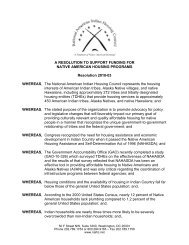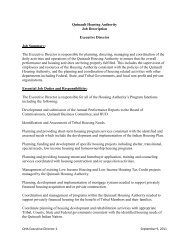CASE STUDY - National American Indian Housing Council
CASE STUDY - National American Indian Housing Council
CASE STUDY - National American Indian Housing Council
Create successful ePaper yourself
Turn your PDF publications into a flip-book with our unique Google optimized e-Paper software.
• Community deterioration: Native <strong>American</strong> communities are empowered byactivities that are relevant to their people and that coincide with their accustomedway of life based on their belief and value systems.• Lack of group sharing: Group sharing of knowledge and responsibilities is a vitalpart of the Native <strong>American</strong> lifestyle. Kindness and care for elders and those whoare less fortunate is a valued trait in all Native <strong>American</strong> communities.• Elder Abuse: Younger Native <strong>American</strong> generations are empowered through theteachings and understandings of their elders. Understanding the respect andsignificant role that elders have within an <strong>Indian</strong> community is a critical factor.• Loss of identification: When tribal members spend time struggling to maintainbasic human needs such as food, shelter, and water, then self-identificationbecomes a critical factor, which retards self-determination for the tribalgovernment.How did the tribe find a solution?This issue was brought to the Tribal <strong>Council</strong> for discussion. The Tribal <strong>Council</strong>supported and passed a resolution for construction of an elder center. ThroughNAHASDA, under the fundable activity of Model Activities, the Bay Mills <strong>Indian</strong>Community was able to leverage from other resources to have sufficient funding forconstruction.How did Bay Mills finance the project?FINANCIAL RESOURCESThe tribe leveraged NAHASDA funds, tribal funds and an <strong>Indian</strong> CommunityDevelopment Block Grant (ICDBG).The <strong>Indian</strong> Community Development Block Grant is available through the U.SDepartment of <strong>Housing</strong> and Urban Development (HUD). Tribes may use block grants toimprove current housing stock, provide community facilities, make infrastructureimprovements, and increase job opportunities by supporting economic development.Some of the activities that are fundable are as follows:• <strong>Housing</strong> rehabilitation• Acquisition of land• Assistance for homeownership• Construction of tribal facilities for single or multi-use2




